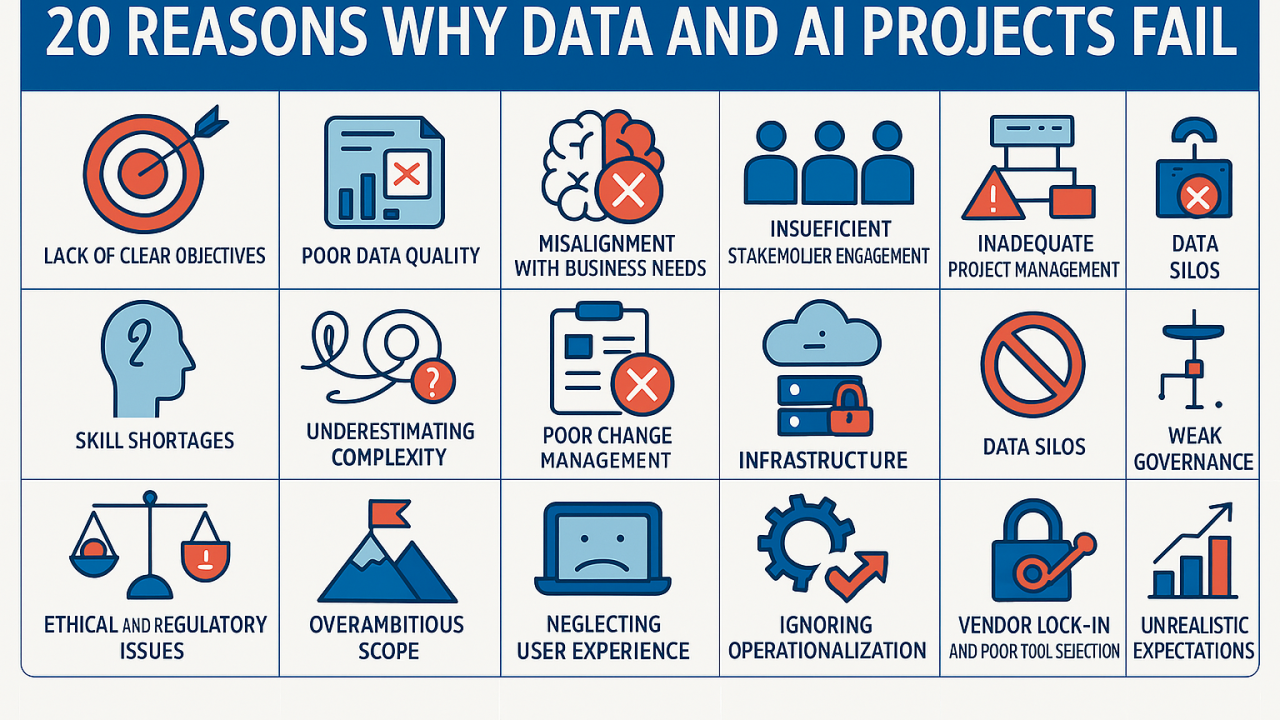

Avoid AI an Data failure, learn from other company's mistakes

In the race to leverage data and artificial intelligence, many businesses enthusiastically initiate projects expecting transformative results, only to find themselves facing failure. Understanding common pitfalls can dramatically improve success rates. Here are 20 critical reasons data and AI projects often fail and practical steps to overcome them:
Lack of Clear Objectives: Define precise goals and measurable KPIs before starting any project.
Poor Data Quality: Invest in thorough data cleansing, validation, and governance processes.
Misalignment with Business Needs: Engage stakeholders early and align AI projects with real-world business challenges (One easy quick win, one hard one to start with).
Insufficient Stakeholder Engagement: Maintain constant communication and involve stakeholders throughout the project lifecycle (News letters, prepare the StirCo and DirCo.
Inadequate Project Management: Adopt structured methodologies based on the type of project. (Agile most of the time does not apply to data governance for example).
Skill Shortages: Prioritize talent development through training or strategic hiring to bridge skill gaps (You might have to change the company’s philosophy in the process).
Underestimating Complexity: Conduct thorough feasibility studies and proof-of-concept phases. In case of AI, everything is often a proof of concept that will improve over time. Do not over sell.
Poor Change Management: Develop comprehensive change management strategies, including training and communication plans. I will impact your skill shortage if you are seen as change management champion in the industry.
Lack of Infrastructure: Ensure robust and scalable infrastructure is in place from the outset. In case of AI, do not focus only on one solution. If you can, try an open source project to challenge your team.
Data Silos: Foster a data-driven culture that promotes cross-functional collaboration and integration. Do not to onboard the data governance as early as possible.
Ethical and Regulatory Issues: Embed compliance, privacy, and ethical guidelines into your AI strategy before you start injecting your data in the model(s).
Weak Governance: Establish clear data and AI governance frameworks to oversee projects. The Governance team should be involved during the complete product life cycle.
Overambitious Scope: Start small, prove value, then scale progressively (again choose one hard and one easy project).
Neglecting User Experience: Prioritize end-user engagement and usability from design to deployment (Users should be in the squads).
Poor Communication: Encourage transparent, continuous communication between technical and business teams (work as squads).
Failure to Iterate: Embrace iterative development cycles to adapt quickly based on feedback.
Insufficient Budget and Resources: Set realistic budgets and allocate resources appropriately, including contingency planning (value project that are on budget but do not flame grill projects that are over budgets, most of the time their scopes have changed overtime.
Ignoring Operationalization: Plan deployment, maintenance, and management of AI models early. They should be seen as products.
Vendor Lock-in and Poor Tool Selection: Choose flexible, interoperable tools and technologies that meet long-term needs. Good luck…
Unrealistic Expectations: Set realistic, achievable expectations and educate stakeholders about AI’s potential and limitations. The technologies will improve so fast that the products life cycles cannot be forecasted anyway.
Industry Examples:
Healthcare: A hospital group initiated an AI project to predict patient readmissions. However, due to poor data quality and fragmented systems (data silos), the predictive models performed poorly, leading to abandoned efforts and lost investments.
Retail: A large retail chain deployed AI-driven inventory forecasting but failed to involve store managers early on. The lack of stakeholder engagement and poor communication led to mistrust and resistance, resulting in continued reliance on traditional forecasting methods.
Finance: A bank launched an AI system to automate loan approvals. Due to inadequate governance and overlooked regulatory compliance issues, the project faced regulatory scrutiny and was ultimately shut down, damaging the bank's reputation and causing significant financial loss.
By proactively addressing these pitfalls, organizations can dramatically improve the outcomes of their data and AI initiatives.
Have you experienced these issues in your projects? What strategies worked for you?
#DataScience #AI #MachineLearning #ProjectManagement #Leadership
Expert analysis on data, cloud, and change management.

In Europe, the role of the Chief Data Officer (CDO) is still finding its place in the executive suite. It's the same in many countires in Asia and it is an issue

Multi-cloud strategy can seem appealing at first. But as firms scale, they’re hit with overwhelming issues that can break more than the bank

Did you hear about the Data Fabric design concept and architecture? Here is a breakdown of how it enables seamless data integration, governance, and real-time insights across hybrid environments
Expert guidance for seamless cloud and data transitions. Unlock value, ensure compliance, and lead with confidence.